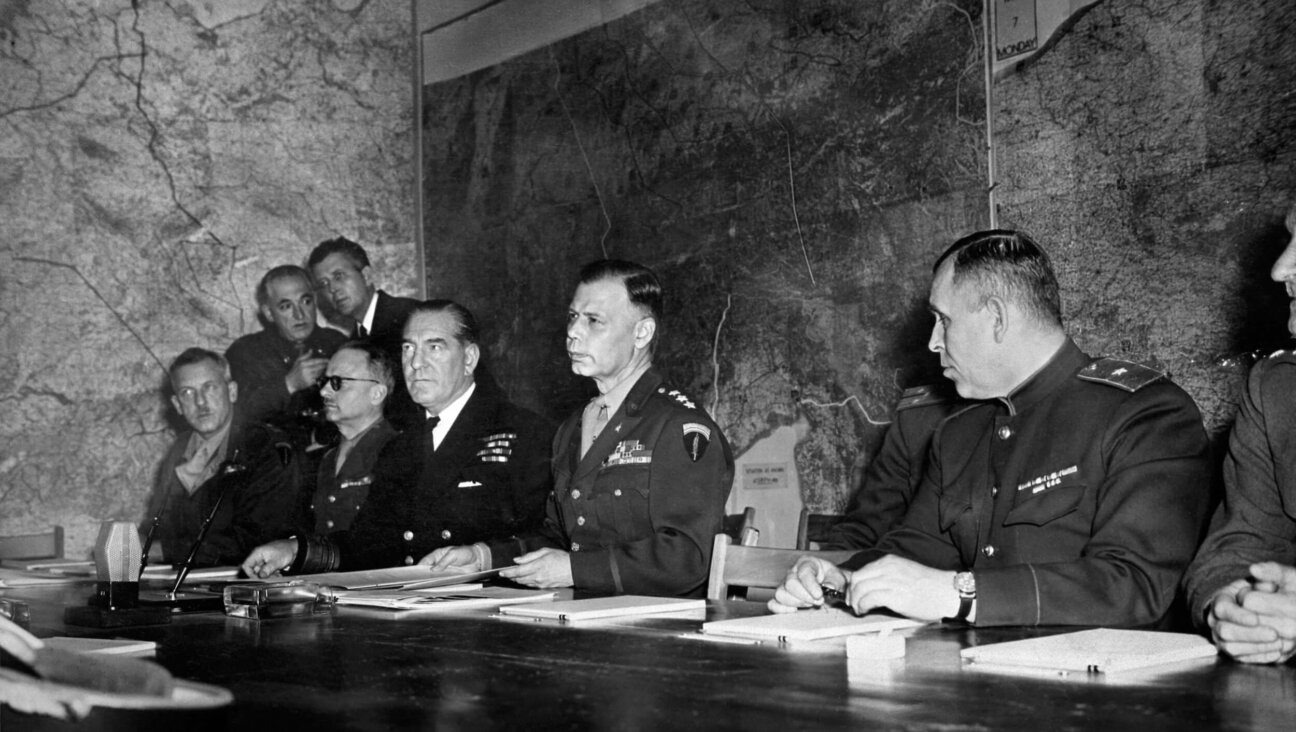Readers Write: My ‘Generation to Generation’ Generated Respons-a
Readers sent in some illuminating responses to my pre-Passover Good Fences column about a recent family Bar Mitzvah ceremony where the rabbi included the child’s non-Jewish father in the service in what struck me as an unusually and admirably welcoming fashion.
This first reply came from a rabbi in Southern California, who makes an important point that I didn’t cover as I might have. I didn’t get permission to use his name, so I’ll leave it out, with apologies.
I have read your articles for a long time. I always appreciate your insights. I am so glad you had a positive experience at the Bar Mitzvah you spoke of. I too believe in being true to our tradition and at the same time being inclusive — the two are not mutually exclusive. You wrote, “…open its gates as few other rabbis have done, building the future without betraying the past.” This is a wonderful compliment to the rabbi, but what you describe here is called Reform Judaism. We proudly welcome non-Jewish family and parents who have raised their children Jewish onto the bimah. We have non-Jewish grandparents read prayers that don’t compromise their integrity or the integrity of the service, but allow them to be a crucial part of their family’s celebration. The non-Jewish parent gives a charge to the kid as does the Jewish parent. In every way that is in keeping with the non-Jewish parent’s comfort level and that which is in keeping with Judaism, the parent participates. A few years ago, Rabbi Janet Marder of California, on the High Holy days, had all the non-Jewish parents rise and she blessed them for raising their children Jewish. (Click here for her text.) So I guess my thought is that what you experienced is not such an anomaly, but rather this happens everyday, in keeping with our Jewish heritage, but yet in a very inclusive way. Your comment struck me and so I wanted to simply share with you what happens on the ground every day.
The High Holy Days sermon he mentions is worth checking out, by the way. Janet Marder is a former national president of the Central Conference of American Rabbis, the Reform rabbinical association, and is the senior rabbi of Congregation Beth Am in Los Altos Hills, near San Francisco (not the same as Congregation Beth Am in Los Angeles, which is Conservative).
Here’s what I wrote back to him:
Actually, it’s a little more complicated than simply equating this with Reform Judaism. When I mentioned having seen this in non-traditional services but not in “traditional, old-fashioned Hebrew davening,” what I had in mind was that it’s not unusual in Reform synagogues but I hadn’t seen it in a strictly halachic congregation such as Rabbi Schuck tries to maintain. It would have made more sense if I had simply said “halachic” but I hadn’t had a chance at that point to talk with Rabbi Schuck about the halachic reasoning behind the decisions, so I tried to work around it rather than guess what he had in mind.
It’s not news that Reform Judaism is doing important and pioneering work in this area. But because Reform doesn’t treat the halachic process as obligatory, its innovations don’t have as much impact as you or I might wish on the other movements to its right. On the other hand Conservative innovations within halacha do have an impact on Orthodox thinking and ruling. That was what made this news in my mind. I hope what I’m saying doesn’t offend — it’s just how I read the landscape.
This next one came from the opposite direction, ritually speaking. Perry Dane, a law professor at Rutgers University, questions whether I didn’t misstate the halachic important of what I had seen that day.
I wasn’t there, so I can’t be sure, but I wonder if J.J. Goldberg is mistaken when he writes that a non-Jewish father of a Bar Mitzvah received an actual aliyah at a Conservative synagogue. I say that because the rabbi’s words that he quotes, beginning “Mi Sheberach avoteinu,” don’t constitute the summons to an aliyah, as Goldberg suggests, but rather the blessing recited from the bimah during the Torah service on behalf of named persons, including but not only persons who have had an aliyah. This would also make sense. An aliyah is an individual liturgical act performed on behalf of the entire Jewish community, and it shows no disrespect to non-Jews to limit it to Jews. The “Mi Sheberach,” on the other hand, is a communal liturgical act performed on behalf of individuals, and it would be both appropriate and even beautiful to recite it on behalf of any parent, Jewish or non-Jewish, who helps nurture and prepare a child for Jewish adulthood.
The minute I read it I realized he was correct and he had caught me in a boo-boo, so I replied:
I looked back at my column after reading your note and I see that I used poor phrasing. Geoff did not receive an aliya to read the Torah. He was named in the Mi Sheberach and then stood with his wife Anne while she recited the blessings. My apologies for the misleading reference to the Mi Sheberach as a summons. And, to be honest, I don’t remember how the rabbi phrased the actual “ya’amod” summons. The point I wanted to make was that I found it striking that Geoff’s name was included by the rabbi in two separate Hebrew ritual prayers (the Mi Sheberach and the blessing of the Bar Mitzvah’s parents). That is to say, Rabbi Schuck found a halachically viable way to include and perhaps honor the non-Jewish parent.
Professor Dane replied:
Thanks for writing back. I guess that was my point — that Rabbi Schuck’s solution (which I surmised and you now confirm) was gracious, choreographically elegant, and halakhically sound. An actual aliyah, it seems to me, would have sounded a false note, on both halakhic and symbolic grounds.
Your column did prompt me to look up Rabbi Schuck on the web. He does seem pretty remarkable. I especially liked his blog entry on the design of interfaith Thanksgiving services. It forms a very nice counterpoint to your Bar Mitzvah story, since it emphasizes the value of religious groups coming together in a celebration of their radical diversity, and not merely in a bland effort at reducing differences to their least common denominator.
One more response — this one from Ed Case, the CEO of InterfaithFamily.com, which offers Jewish resources to mixed-faith families and lobbies Jewish communities to open their doors. He didn’t write a note but simply sent me a link to his blog post on the column. His take was enthusiastic and flattering but also credited me with an opinion I don’t quite share:
When more Jewish leaders recognize that Goldberg’s cousin’s family — with an unconverted non-Jewish parent participating in raising a Jewish child — is not sub-optimal, but instead is a positive Jewish outcome equal to any other — then we will have a truly “changing Judaism.” I hope Goldberg’s essay will help move us in that direction.
Here’s what I wrote back:
One small quibble. To be honest, I don’t think that the outcome of growing up Jewish in an interfaith family is equal to any other outcome (and I don’t think I said that). My understanding is that children of two Jewish parents who are raised in a strong Jewish family environment are likely to have less ambiguous senses of Jewish identity and are less likely to ignore their Jewish identity when they grow up. I would argue, though, that that horse has left the barn. The question isn’t whether there will be large numbers of children of interfaith parentaqe. There already are and there will be more. The question is how to respond to the new reality.
For the record, I did get a reply from Rabbi Schuck about the thinking behind his innovation. It came in just a few minutes before the Passover holiday began Monday evening and I didn’t see it until Wednesday evening, by which time the column was already in print. So I’ll let him have the last word:
In my community, parents who are not Jewish are very often intensely supportive of their child’s Jewish education. They nurture their child’s Jewish life in deeply meaningful ways. I work hard to create opportunities to celebrate this decision, to be inclusive of the non-Jewish parent in the simcha, and I do so within the boundaries permitted by halacha. This can be challenging because of the many halachic limitations, but when these limitations are communicated to the family along with the opportunities for inclusion, I think families understand and respect them, as well as feel integrated into the day. I have been inspired by my community’s capacity to be welcoming and loving to the non-Jewish spouse while maintaining its commitment to a halachic framework.
The Forward is free to read, but it isn’t free to produce

I hope you appreciated this article. Before you go, I’d like to ask you to please support the Forward.
Now more than ever, American Jews need independent news they can trust, with reporting driven by truth, not ideology. We serve you, not any ideological agenda.
At a time when other newsrooms are closing or cutting back, the Forward has removed its paywall and invested additional resources to report on the ground from Israel and around the U.S. on the impact of the war, rising antisemitism and polarized discourse.
This is a great time to support independent Jewish journalism you rely on. Make a gift today!
— Rachel Fishman Feddersen, Publisher and CEO
Support our mission to tell the Jewish story fully and fairly.
Most Popular
- 1

Culture Cardinals are Catholic, not Jewish — so why do they all wear yarmulkes?
- 2

Fast Forward Ye debuts ‘Heil Hitler’ music video that includes a sample of a Hitler speech
- 3

News School Israel trip turns ‘terrifying’ for LA students attacked by Israeli teens
- 4

Fast Forward Student suspended for ‘F— the Jews’ video defends himself on antisemitic podcast
In Case You Missed It
-

Yiddish קאָנצערט לכּבֿוד דעם ייִדישן שרײַבער און רעדאַקטאָר באָריס סאַנדלערConcert honoring Yiddish writer and editor Boris Sandler
דער בעל־שׂימחה האָט יאָרן לאַנג געדינט ווי דער רעדאַקטאָר פֿונעם ייִדישן פֿאָרווערטס.
-

Fast Forward Trump’s new pick for surgeon general blames the Nazis for pesticides on our food
-

Fast Forward Jewish feud over Trump escalates with open letter in The New York Times
-

Fast Forward First American pope, Leo XIV, studied under a leader in Jewish-Catholic relations
-
Shop the Forward Store
100% of profits support our journalism
Republish This Story
Please read before republishing
We’re happy to make this story available to republish for free, unless it originated with JTA, Haaretz or another publication (as indicated on the article) and as long as you follow our guidelines.
You must comply with the following:
- Credit the Forward
- Retain our pixel
- Preserve our canonical link in Google search
- Add a noindex tag in Google search
See our full guidelines for more information, and this guide for detail about canonical URLs.
To republish, copy the HTML by clicking on the yellow button to the right; it includes our tracking pixel, all paragraph styles and hyperlinks, the author byline and credit to the Forward. It does not include images; to avoid copyright violations, you must add them manually, following our guidelines. Please email us at [email protected], subject line “republish,” with any questions or to let us know what stories you’re picking up.
















